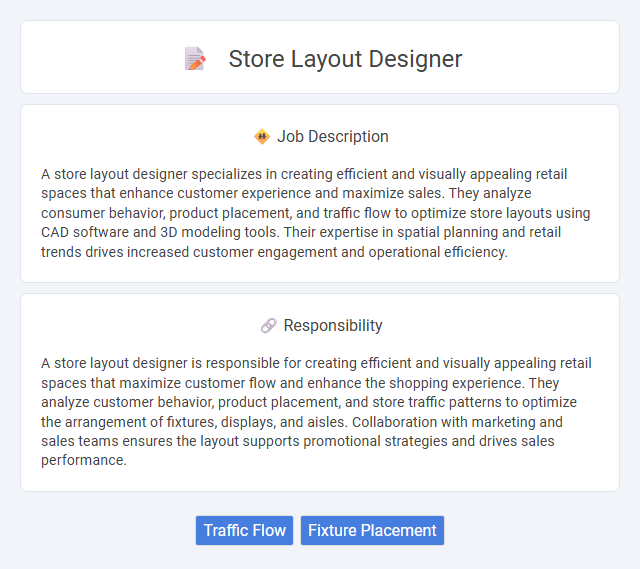
A store layout designer specializes in creating efficient and visually appealing retail spaces that enhance customer experience and maximize sales. They analyze consumer behavior, product placement, and traffic flow to optimize store layouts using CAD software and 3D modeling tools. Their expertise in spatial planning and retail trends drives increased customer engagement and operational efficiency.
Individuals with strong spatial awareness and creativity are likely to excel as store layout designers, as the role demands the ability to visualize and arrange retail spaces effectively. Those who enjoy problem-solving and have an eye for detail might find this job highly suitable, given its emphasis on optimizing customer flow and product placement. Conversely, people who prefer routine tasks or lack interest in design concepts may struggle to find satisfaction or success in this position.
Qualification
A Store Layout Designer must possess strong skills in spatial planning, interior design, and ergonomics to create efficient and visually appealing retail environments. Proficiency in CAD software and 3D modeling tools like AutoCAD and SketchUp is essential for drafting detailed layouts and visualizations. A background in architecture, interior design, or retail management combined with experience in consumer behavior analysis enhances their ability to optimize store traffic flow and product placement effectively.
Responsibility
A store layout designer is responsible for creating efficient and visually appealing retail spaces that maximize customer flow and enhance the shopping experience. They analyze customer behavior, product placement, and store traffic patterns to optimize the arrangement of fixtures, displays, and aisles. Collaboration with marketing and sales teams ensures the layout supports promotional strategies and drives sales performance.
Benefit
A store layout designer likely improves customer flow and maximizes product visibility, increasing overall sales potential. Efficient designs probably enhance the shopping experience, encouraging longer visits and higher purchase rates. Optimized layouts may also reduce operational costs by streamlining space utilization and employee movement.
Challenge
Designing a store layout likely involves complex challenges, such as optimizing space to enhance customer flow while maximizing product visibility. Balancing aesthetic appeal with practical constraints may demand innovative problem-solving skills. The role probably requires adaptability to evolving retail trends and consumer behaviors.
Career Advancement
Store layout designers enhance retail environments by strategically arranging products to maximize customer engagement and sales, leveraging skills in spatial planning and consumer psychology. Career advancement opportunities often include roles such as senior designer, retail environment consultant, or creative director, offering increased responsibility in project management and cross-functional collaboration. Mastery of CAD software and trends in consumer behavior analysis can significantly boost prospects for promotion and leadership within retail design firms.
Key Terms
Traffic Flow
A store layout designer strategically plans traffic flow to maximize customer movement and engagement within retail spaces. By analyzing consumer behavior patterns and optimizing aisle placement, designers enhance accessibility to high-demand products and improve overall shopping experience. Efficient traffic flow reduces congestion, increases dwell time, and ultimately drives higher sales conversions.
Fixture Placement
Fixture placement in store layout design maximizes customer flow and enhances product visibility by strategically positioning displays and shelving units. Optimal fixture arrangement drives sales by creating engaging shopping experiences and facilitating easy navigation. Experts analyze traffic patterns and shopper behavior to ensure efficient use of retail space and promote key merchandise.
 kuljobs.com
kuljobs.com